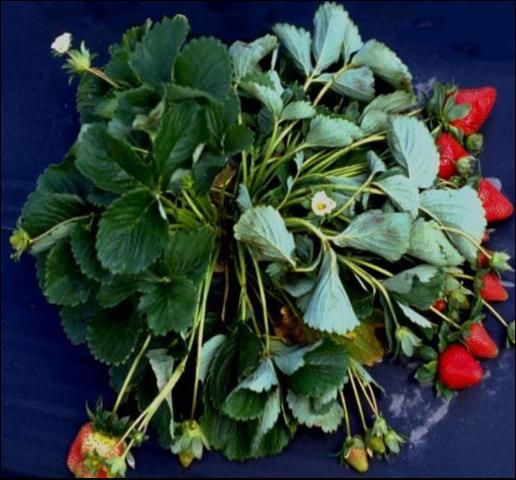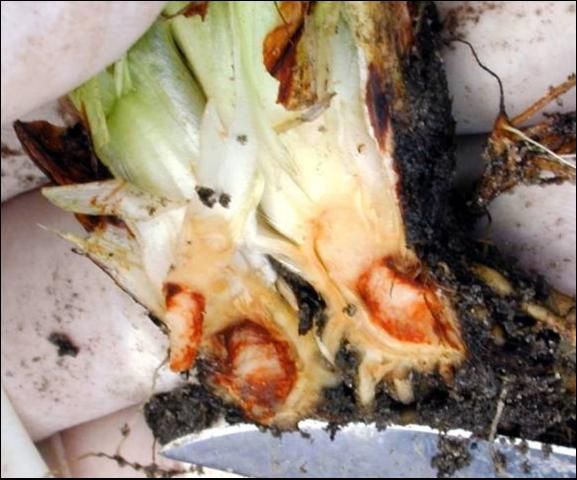Colletotrichum crown rot is caused by fungi in the Colletotrichum gloeosporioides species complex. These pathogens kill strawberry plants by aggressively invading crown tissue. Crown rot is a serious disease in warm production regions, such as those in the southeastern United States, since C. gloeosporioides grow and reproduce best at temperatures greater than 25°C (77°F). Although crown rot is observed in fields during the winter production season in Florida, it is most severe in nurseries in the southeastern United States and is one of the primary reasons that transplant production moved to cooler regions. Another species of Colletotrichum, C. acutatum, also causes plants to decline in vigor and wilt. Although it is sometimes isolated from crown tissue, decline and wilt symptoms caused by this species are generally due to bud and root infection.
Causal Agent and Symptoms
The symptoms caused by C. gloeosporioides species complex are virtually indistinguishable in the field. Plants infected with virulent strains initially show signs of water stress and subsequently collapse (Figure 1). This process may occur relatively rapidly, taking only 2 or 3 days at optimum temperatures (around 80°F). At lower temperatures (~68°F), plants may show initial signs of stress, but it could take several weeks before they collapse. Cutting through the crown tissue of infected plants lengthwise reveals a reddish-brown, firm rot (Figure 2). Infected (asymptomatic) plants from nurseries may grow normally for some time before symptoms occur. There are typically no lesions on foliage or stolons in production fields, although, under greenhouse conditions or in summer nurseries, necrosis on stolons, lesions on fruit, or black leaf spots may be visible. Symptoms of Colletotrichum crown rot may be confused with those of Phytophthora crown rot (caused by Phytophthora cactorum) and charcoal rot (caused by Macrophomina phaseolina). To confirm a diagnosis, the pathogen must be isolated from the diseased crowns and identified in the laboratory.

Credit: UF/IFAS GCREC

Credit: UF/IFAS GCREC
Disease Development and Spread
Plant propagation in Canada and northern states for the Florida production season has greatly reduced the incidence of Colletotrichum crown rot. Currently, during the warm months at the beginning and end of the production season, crown rot incidences up to 5% still occur on plants in Florida fields. Plants can become infected after transplant since C. gloeosporioides are abundant on noncultivated hosts in Florida, and genetic data indicate that they are from the same population as those from strawberry crowns. Although inoculum from plants showing symptoms at the beginning of a production season can spread to other plants by the end of the season, the disease does not appear to be multicyclic and usually does not spread quickly from symptomatic to healthy plants. Colletotrichum spp. responsible for crown rot do not appear to survive between seasons on plant debris when plants are killed immediately after the production season ends in the spring, and the fungus disappears from crowns, plant residues, and soil during the hot and humid summer months in Florida.
There are no known cultivars that are immune to Colletotrichum crown rot, although cultivars do differ in susceptibility. The use of tolerant cultivars delays the onset of disease until later in the season or reduces the incidence of crown rot. Cultivars such as 'Strawberry Festival', 'Florida Brilliance', and 'Florida Beauty' are considered susceptible, whereas 'Florida Radiance' and 'Sensation® Florida 127' show moderate levels of resistance.
Disease Management
Using disease-free transplants and cultivar resistance are the most effective methods for controlling Colletotrichum crown rot in strawberry production fields. Currently, there is no certification program to guarantee that transplants are free of crown rot, and infected plants may not show symptoms until they have been established in the field. Transplants from northern latitudes or high-altitude nurseries in Canada and California should be disease-free since C. gloeosporioides is not present in these regions. Weekly foliar sprays of protectant fungicides such as captan are effective in suppressing the spread of crown rot from infected to healthy plants and reducing infections coming from native vegetation. However, protectant fungicides do not hinder the progress of symptoms in plants that are already infected. In this case, a single-site fungicide might be more effective, unless resistant strains are present in the field (see Table 1). Cultural practices that reduce the occurrence and movement of water on foliage, such as the use of drip irrigation, limits the dispersal of the pathogen. Plants are also more sensitive to infection under high fertility conditions. Reduced nitrogen rates in nurseries or the use of nitrate rather than ammonium nitrogen sources may also reduce risk of infection.